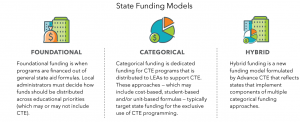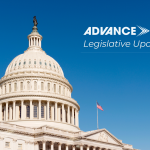Providing high-quality Career Technical Education (CTE) requires robust, sustained funding designed to be responsive to the evolving and diverse needs of industry and learners. State leaders make decisions every day on how to direct funding where it is needed most and having knowledge about how other states are funding secondary CTE will help with decision making. Adequate and equitable funding allows learners to engage in a cohesive, flexible and responsive career preparation system as described in Without Limits: A Shared Vision for the Future of Career Technical Eduction (CTE Without Limits). This blog provides a background on CTE funding and describes various models and approaches states use to fund secondary CTE.
States rely on a mix of federal, state and local policies to provide funding sources for secondary CTE.[efn_note]Center for Public Education. (2016, December). Career and technical education: Building new pathways into the labor market. https://files.eric.ed.gov/fulltext/ED608870.pdf[/efn_note] The Carl D. Perkins Career and Technical Education Act (Perkins V*) is the primary federal investment in secondary and postsecondary CTE. A state’s share of funding is determined by a statutory formula based on the age distribution of the state’s population and its per-capita income. The remaining 15 percent of allocations are used to support state leadership and administration activities.[efn_note]Perkins Collaborative Resource Network. (n.d.). Perkins V [Video]. https://cte.ed.gov/legislation/perkins-v[/efn_note] States have flexibility in determining how funds are allocated between secondary and postsecondary CTE, with an average of 62 percent of funding going to secondary programs and 38 percent supporting postsecondary programs for fiscal year 2022 (FY22).[efn_note]Perkins Collaborative Resource Network. (2023). Split secondary and postsecondary awards in 2022. https://s3.amazonaws.com/PCRN/file/SplitSecondaryAndPostsecondaryAwards2022.pdf[/efn_note]
CTE programs can be costly to run because of the need for specialized equipment/facilities, smaller class sizes and additional staffing.[efn_note]Klein, S. (2001). Financing vocational education: A state policymaker’s guide. MPR Associates.[/efn_note] Federal funding through Perkins V alone cannot meet those costs, so many states make a financial commitment to support CTE. Local and philanthropic partners also support CTE at the district level. Funding at the state level for secondary CTE is varied and complex.
However, there are distinct processes that can be organized into several state models. To categorize state funding models for FY22, Advance CTE used the definitions of foundational and categorical funding and the respective approaches found in State Strategies for Financing Career and Technical Education[efn_note]U.S. Department of Education, Office of Career, Technical, and Adult Education. (2014). State strategies for financing career and technical education. https://files.eric.ed.gov/fulltext/ED555236.pdf[/efn_note]; additionally, a new definition of hybrid funding was developed.

Foundational funding finances programs out of general state aid formulas. Local administrators must decide how funds should be distributed across educational priorities (which may or may not include CTE).[efn_note]U.S. Department of Education, Office of Career, Technical, and Adult Education. (2014). State strategies for financing career and technical education. https://files.eric.ed.gov/fulltext/ED555236.pdf, x.[/efn_note]
Categorical funding is dedicated funding for CTE programs that is distributed to Local Education Agencies (LEAs) to support CTE. These approaches — which may include cost-based, student-based and/or unit-based formulas — typically target state funding for the use of CTE programming.[efn_note]U.S. Department of Education, Office of Career, Technical, and Adult Education. (2014). State strategies for financing career and technical education. https://files.eric.ed.gov/fulltext/ED555236.pdf, x.[/efn_note] There are three approaches to how LEAs receive this funding:
- Cost-based approach — LEAs are compensated for CTE services based on their actual reported costs from the prior academic year. States may cap or limit the rate at which eligible expenses are reimbursed.[efn_note]U.S. Department of Education, Office of Career, Technical, and Adult Education. (2014). State strategies for financing career and technical education. https://files.eric.ed.gov/fulltext/ED555236.pdf, xi.[/efn_note]
- Student-based approach — States distribute funds relative to the number of CTE learners enrolled based on the full-time equivalent or average daily membership calculation in an LEA.
[efn_note]U.S. Department of Education, Office of Career, Technical, and Adult Education. (2014). State strategies for financing career and technical education. https://files.eric.ed.gov/fulltext/ED555236.pdf, x.[/efn_note]
- Unit-based approach — States distribute funds based on a set of educational units (and their related costs) used to deliver CTE. Units may include pupils, instructors, equipment or materials.[efn_note]U.S. Department of Education, Office of Career, Technical, and Adult Education. (2014). State strategies for financing career and technical education. https://files.eric.ed.gov/fulltext/ED555236.pdf, xi.[/efn_note]
Hybrid funding is a new funding model formulated by Advance CTE that reflects states that implement components of multiple categorical funding approaches.
States may also direct funding specifically for area technical centers (ATCs) to deliver CTE programming. This funding is often in addition to one of the previously stated models, which fund secondary CTE programs more broadly across a state. More information about ATCs can be found in Advance CTE’s website: A 50-State Analysis of Area Technical Centers.[efn_note] Advance CTE. (n.d.). A 50-state analysis of area technical centers. https://areatechnicalcenters.org/[/efn_note]
Advance CTE recognizes that state leaders desire more in-depth information about secondary state CTE funding to maximize current models or to pursue reforms towards more effective and equitable funding models. To meet this need, stay tuned for the release of our 2023 State of CTE: An Analysis of State Secondary CTE Funding Models in late August! The research report and accompanying website provide insights into current national trends in state secondary CTE funding and recommendations to enhance equity in the design and delivery of funding.
*As amended by the Strengthening Career and Technical Education for the 21st Century Act
Dr. Laura Maldonado, Senior Research Associate

